
Placodermi is a class of armoured prehistoric fish, known from fossils, which lived from the Silurian to the end of the Devonian period. Their head and thorax were covered by articulated armoured plates and the rest of the body was scaled or naked, depending on the species. Placoderms were among the first jawed fish; their jaws likely evolved from the first of their gill arches.
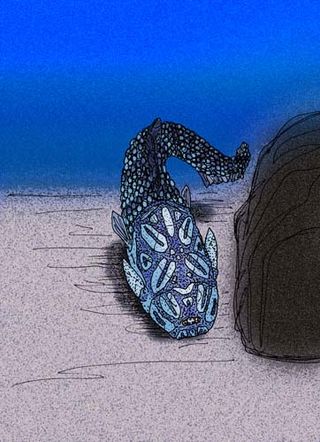
Mizia is a genus of primitive antiarch placoderm found in Emsian-aged marine strata of Early Devonian China.

Antiarchi is an order of heavily armored placoderms. The antiarchs form the second-most successful group of placoderms after the arthrodires in terms of numbers of species and range of environments. The order's name was coined by Edward Drinker Cope, who, when examining some fossils that he thought were armored tunicates related to Chelyosoma, mistakenly thought that the orbital fenestra was the opening for the mouth, or oral siphon, and that the opening for the anal siphon was on the other side of the body, as opposed to having both oral and anal siphons together at one end.

Quasipetalichthys haikouensis is the type and only known species of the extinct petalichthid placoderm, Quasipetalichthys. Fossil remains of Quasipetalichthys have been found in the Middle Devonian, Givetian faunal stage of China.

Aleosteus is an extinct monospecific genus of arthrodire placoderm fish of the Early Devonian period. The type species Aleosteus eganensis was described in 2000, and was found in the Late Emsian strate of the Sevy Dolomite Formation, in the Egan Range of east-central Nevada, USA. Almost complete fossils belong to juvenile and adult specimens and show a short and broad skull, posteriorly concave.
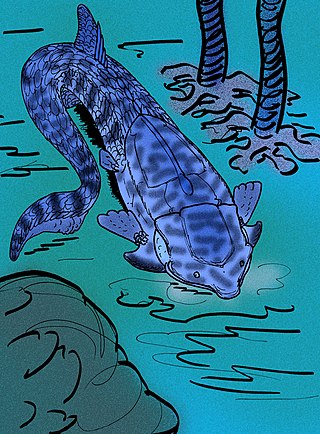
Silurolepis platydorsalis is a species of Silurian-aged "maxillate" early placoderm that has been described from (mostly) articulated remains. Although it has been known for several years, it was finally described by Zhang, et al., in 2010.

Xiangshuiosteus wui is an extinct monospecific genus of brachythoracid arthrodire placoderm from the Late Emsian stage of the Early Devonian epoch, discovered in Wuding County of Yunnan province, China. It has recently been reassessed as a dunkleosteid.
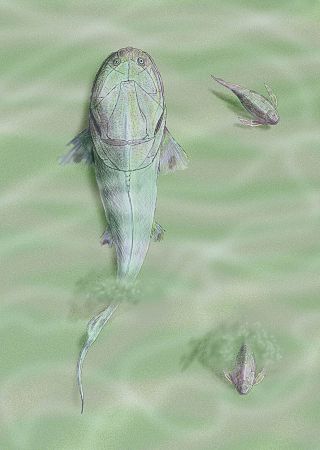
Homostiidae is a family of flattened arthrodire placoderms from the Early to Middle Devonian. Fossils appear in various strata in Europe, Russia, Morocco, Australia, Canada and Greenland.

Heterosteidae is an extinct family of moderately large to giant, flattened, benthic arthrodire placoderms with distinctive, flattened, triangular skulls that are extremely broad posteriorly, but become very narrow anteriorly.

Coccosteidae is a family of arthrodire placoderms from the Early to Late Devonian. Fossils appear in various strata in Europe, North America and China.

Jiuchengia longoccipita is a coccosteid arthrodire placoderm from the Late Emsian epoch of Wuding, Yunnan.
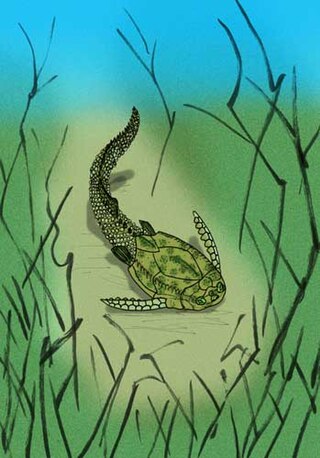
Parayunnanolepis xitunensis is an extinct, primitive antiarch placoderm. The fossil specimens, including a marvelously preserved, intact specimen, are known from the Lochkovian Epoch-aged Xitun Formation of Early Devonian Yunnan. The armor is very similar to that of Yunnanolepis, but is distinguished by being comparatively more flattened.
Microbrachiidae is an extinct family of tiny, advanced antiarch placoderms closely related to the bothriolepidids.
Microbrachius is an extinct genus of tiny, advanced antiarch placoderms closely related to the bothriolepids. Specimens range in age from the Lower Devonian Late Emsian Stage to the Middle Devonian Upper Givetian Stage. They are characterized by having large heads with short thoracic armor of an average length of 2-4 cm. There are patterns of small, but noticeable tubercles on the armor, with the arrangement varying from species to species. Specimens of Microbrachius have been found in Scotland, Belarus, Estonia, and China.

Bothriolepidoidei is a suborder of antiarch placoderm fishes. The group is considered paraphyletic.

Wufengshania is an extinct genus of bothriolepidid placoderm from the Emsian epoch of China. The type species, Wufengshania magniforaminiswas named by Zhaohui Pan et al., 2018.
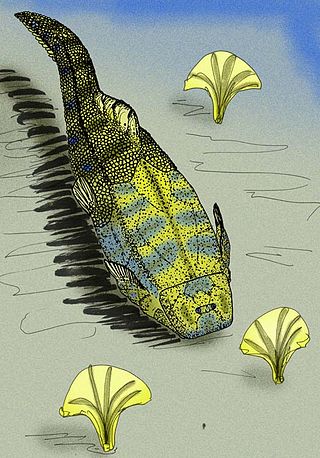
Shimenolepis granifera is an extinct yunnanolepid placoderm from the Xiaoxi Formation, Li County, Hunan, China. Its age is discussed, while originally considered as late Llandovery, it is later considered to belong to the Ludlow Epoch instead. It was the first described Silurian placoderm, and was the earliest known placoderm until Xiushanosteus was described, known from distinctively ordered plates.
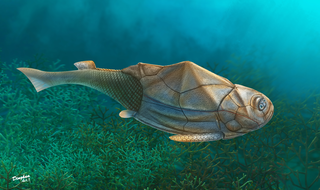
Phymolepis is an extinct genus of yunnanolepidid placoderm from the Early Devonian of China. The type species, P. cuifengshanensis, was named by Zhang Goroui in 1978 and was re-evaluated in 2018, while a second species, P. guoruii, was named and described in 1996.
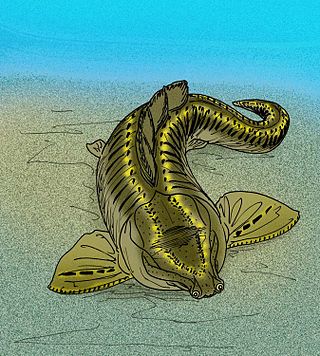
Yinostius is an extinct genus of heterosteid placoderm of the Middle Devonian known from remains discovered in China.

Herasmius is an extinct genus of heterosteid placoderm from the Devonian period. Fossils have been discovered freshwater deposits in Norway and Canada.



















